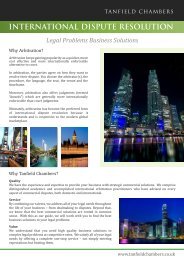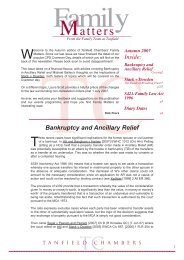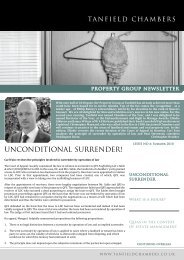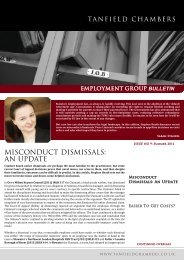Link to newsletter - Tanfield Chambers
Link to newsletter - Tanfield Chambers
Link to newsletter - Tanfield Chambers
You also want an ePaper? Increase the reach of your titles
YUMPU automatically turns print PDFs into web optimized ePapers that Google loves.
our authors<br />
It is not sufficient simply <strong>to</strong> rely on a covenant between the original<br />
parties – if the land is sold prior <strong>to</strong> the overage trigger event occurring<br />
there will be no privity of contract between the respective owners<br />
when the condition is eventually satisfied. Moreover, the burden of a<br />
positive covenant does not run with the land at law or in equity (unlike<br />
the burden of restrictive (i.e. negative) covenants which can run in<br />
equity <strong>to</strong> bind a buyer). The fact that a subsequent buyer knew of the<br />
covenant does not mean that he is bound by its provisions if it is a<br />
positive covenant. Courts will look at the substance rather than the<br />
form of a covenant in order <strong>to</strong> determine whether it is positive or<br />
negative. Generally, covenants requiring expenditure of money for<br />
their performance are positive in nature (e.g. Austerberry<br />
Corporation v Oldham (1885) 29 ChD 750). Express obligations <strong>to</strong><br />
pay overage are therefore generally regarded as positive.<br />
Accordingly, where an obligation <strong>to</strong> pay overage is contained in a<br />
positive covenant, it must be supported by some other legal device.<br />
One of the most common ways <strong>to</strong> protect a positive overage covenant<br />
is <strong>to</strong> ensure that the buyer also covenants <strong>to</strong> ensure that its successors<br />
in title will enter in<strong>to</strong> a similar commitment <strong>to</strong> the seller. A restriction<br />
is then placed against the buyer’s title preventing any dealing with the<br />
land without the consent of the seller. This method of protecting<br />
overage rights has the benefit of being simple and cost effective as a<br />
standard form restriction can be used (Form N is the one most often<br />
used for overage). The use of a restriction <strong>to</strong> secure overage obligations<br />
is in wide use. However, where the land is <strong>to</strong> be purchased by way of<br />
mortgage, the co-operation of the bank will be required.<br />
Many different techniques have been developed <strong>to</strong> protect overage and<br />
it is necessary <strong>to</strong> give consideration <strong>to</strong> the risks involved and what may<br />
or may not be appropriate depending on the nature of transaction and<br />
the parties there<strong>to</strong>. For example, another form of possible protection is<br />
the use of a ransom strip of land, which would be retained by the seller<br />
so as <strong>to</strong> prevent development until the overage is paid. However, this<br />
would not be applicable where the buyer has an alternative means of<br />
access. An alternative mechanism is for the seller <strong>to</strong> take a charge over<br />
the land <strong>to</strong> secure the future overage payment. However, this will not<br />
usually be appropriate if the land is <strong>to</strong> be purchased with the aid of a<br />
mortgage as the bank may insist upon having a sole legal mortgage<br />
over the land. A lender may allow the seller <strong>to</strong> take a second mortgage<br />
over the land but the lender will want <strong>to</strong> ensure that its mortgage takes<br />
priority.<br />
The seller could impose a restrictive covenant on the land, for example<br />
a covenant not <strong>to</strong> build or develop the land. It should be noted that<br />
attempting <strong>to</strong> rely on a simple restrictive covenant, without reference<br />
<strong>to</strong> money, could cause its own problems. Use of this device requires<br />
that the seller retain some land as there must be some land with the<br />
benefit of the restrictive covenant. Under section 84(1)(aa) of the Law<br />
of Property Act 1925 the Lands Tribunal (Upper Tribunal) has powers<br />
<strong>to</strong> vary and/or release restrictive covenants where the covenant<br />
prevents “some reasonable user” of the land for public or private<br />
purposes. Moreover, compensation payable for variation or discharge<br />
of such a covenant would be determined by reference <strong>to</strong> the “loss or<br />
disadvantage” suffered by the discharge or variation – i.e. essentially<br />
the diminution in value of the land that had benefited from the<br />
covenant, rather than the development value of the developed land.<br />
In summary, where the parties have agreed that overage provisions<br />
will form part of a sale, practitioners must ensure that the sale<br />
agreement is drafted clearly so as <strong>to</strong> address the issues of when<br />
overage will be payable (the trigger event) and how much it will be (the<br />
method of calculation). It is also vital <strong>to</strong> consider how best <strong>to</strong> secure the<br />
overage obligation and which legal device is most suitable for the<br />
particular transaction.<br />
Andrew Sheftel<br />
TC<br />
ACQUIRING FREEHOLD<br />
ARE MISSING<br />
Cecily Crampin considers the options open <strong>to</strong> long leaseholders<br />
When leases are long with little reversionary interest and ground rent is<br />
low, it is not uncommon for landlords <strong>to</strong> go missing leaving properties in<br />
an increasing state of disrepair. An obvious solution is for the lessees <strong>to</strong><br />
acquire the freehold. Advisors for lessees in situations such as these may<br />
suggest collective enfranchisement using the missing landlord procedure.<br />
This article suggests that an acquisition order should be considered as an<br />
alternative route.<br />
Acquisition orders, made by the county court under the Landlord and<br />
Tenant Act 1987 (“LTA”) are often thought of as a second stage <strong>to</strong> the<br />
court’s power <strong>to</strong> appoint a manager for premises. However, an acquisition<br />
order can be made, even when there has been no such manager, if the<br />
landlord is in breach of an obligation <strong>to</strong> the tenants that relates <strong>to</strong> the<br />
management of the premises, and that breach is likely <strong>to</strong> continue. It is<br />
this provision, s29(2) of the LTA, which assists where the landlord cannot<br />
be found, since a landlord who cannot be traced will likely be in breach of<br />
any covenants <strong>to</strong> repair, maintain, improve and insure the premises.<br />
Tracing the landlord<br />
Both applications for acquisition orders and claims for collective<br />
enfranchisement usually start when the qualifying tenants issue a notice<br />
<strong>to</strong> the landlord, the preliminary notice for acquisition orders and the<br />
initial notice for enfranchisement. For both, the relevant statute sets out<br />
what tenants should do if the landlord cannot be traced. The<br />
requirements are similar.<br />
Section 26 of the Leasehold Reform, Housing and Urban Development Act<br />
1993 (“LRHUDA”) governs missing landlords in enfranchisement. Where<br />
neither the freeholder nor any intermediate landlords can be found, the<br />
tenants should apply <strong>to</strong> the county court for a vesting order. For<br />
acquisition orders, an application under s27 of the LTA <strong>to</strong> dispense with<br />
service of the preliminary notice must be made, as well as the application<br />
for an acquisition order.<br />
In both cases, the court may require the tenants <strong>to</strong> take further steps <strong>to</strong><br />
trace the landlord. No statu<strong>to</strong>ry suggestions are made for acquisition<br />
orders, but the requirements are likely <strong>to</strong> be similar <strong>to</strong> those for<br />
enfranchisement, in which advertisement is specifically mentioned<br />
(LRHUDA s26(5)). In both cases, tenants should check the Land Register,<br />
the elec<strong>to</strong>ral roll and the register of deaths, and consider advertising in<br />
local and national papers.<br />
Qualifying tenants and qualifying premises<br />
The qualification requirements for acquisition orders are very similar <strong>to</strong><br />
those for collective enfranchisement. In both cases, qualifying tenants<br />
W W W. TA N F I E L D C H A M B E R S . C O . U K






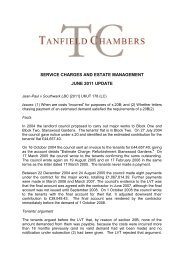
![Re Clarise Properties Ltd [2012] UKUT 4 (LC) - Tanfield Chambers](https://img.yumpu.com/36301708/1/190x245/re-clarise-properties-ltd-2012-ukut-4-lc-tanfield-chambers.jpg?quality=85)


